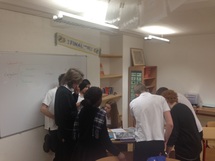 Students working together on a 'running dictation'
Students working together on a 'running dictation' 1. 'Use' of the Target language is key:
Both by the students and the teacher. The teacher should speak almost entirely in the target language but at a level understandable to the students so they get that all important 'comprehensible input'. Students need to wrap their mouth around the new words and sounds they are hearing so should speak the language with their peers and teacher in every class. Pair work and group work is a great help here as are things like 'exit tickets'. As I often say to my students: Do you play an instrument? Do you play a sport? Will you improve your guitar or football playing by just watching someone else do it and studying how their feet or hands move? Maybe a little, yes. But how do you really improve? You need to actually play the guitar or kick the ball. It is the same with learning language.
2. The classroom should be Active, Supportive and Cooperative:
- Active: Varied tasks that get students up and moving at least once during class to keep them awake and concentrated
- Supportive: Everyone should feel comfortable making mistakes and asking questions in the target language
- Cooperative: Students should frequently work together on varied tasks using the target language to communicate.
If, like me, you are a language teacher trying to find this elusive ‘ideal language-learning environment’ maybe all we need to do is follow the advice we routinely give our students: “If you are unsure, just ‘ASC’”.
Below is a paper I wrote entitled "Towards a model for the ideal language learning environment for secondary school adolescent pupils" for anyone who like to read a bit more on this topic. Please do leave your comments below or tweet me @liamprinter.

 RSS Feed
RSS Feed